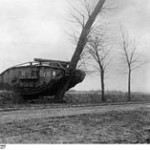by Lauren Pidgeon
Between May 1918 and June 1919, Garey traveled around England, France, and America with the army and spotted many of the new technological inventions of the time.
Although motorized vehicles had been around for quite some time, the army mainly used them for the higher-ranking officers. Garey probably never actually rode in a car or truck during his time in the army. He definitely saw quite a few of them though and enjoyed writing about them in detail.

May 21st, 1918
Burlington, VT
Our trucks drove in about 5 oclock, 12 of them. They are the Ricker Truck made by the Locomobile Co. in Conn. The truck itself weighs 7100lbs and carries a load of 800lbs.
Horses were still in use throughout the war. These horses had to be shipped across to France and were taken care of by the soldiers. Unfortunately horses weren’t a reliable mode of transportation because they could sometimes become sick.
January 27th, 1919
Camp de Meucon, France
A lot of the horses that we had have got the “glanders” and a lot of them have had to be killed. We have got 43 left for the Battery. They took 53 away to the Veteranary Stables today.

Both the Allies and the Axis Powers began to use tanks during World War 1. The Battle of the Somme in 1915 was one of the first battles that used tanks. Here is a picture of a British tank. Almost two-thirds of them broke down either before or during battle. Image from Wikepedia
February 10th, 1919
Camp de Meucon, France
We have got about 115 [horses] now… It is not much work to groom them now as there is no mud for them to lay in and they have blankets on nights.
Gas as a weapon was also a new technological invention. To prepare for gas attacks the soldiers needed to wear their masks a few hours everyday. This is sort of similar to us in the present day who wear our masks everytime we leave the house.
October 25th, 1918
“Somewhere in France”
I remembered that this was my birthday and … I celebrated it by wearing my gas mask about 4 hours. We have to wear them a half hour or so every day and every Friday we wear them one hour the first week and one hour more each week. They are not so bad after you get used to it. That is what we wear them for.
I agree with Garey. Masks aren’t that bad after you get used to them. Of course I’m talking about a cloth mask and he’s talking about a full face gas mask.

Here are some German soldiers and their donkey wearing gas masks.
Image from Universal History Archive
Influenza
Surprisingly, Garey rarely writes about the influenza pandemic except to mention a friend who died of the flu. One possible reason Garey didn’t write about the flu was because the U.S. government tried to hide the fact that America was struggling with the pandemic to make them seem stronger to the soldiers. Unfortunately because the government failed to help it’s people, approximately 675,000 Americans died (according to Stanford University). This is 10 times more Americans who died during the war and 485,000 more Americans than those who have died of COVID to date.
October 17th, 1918
“Somewhere in France”
In Isabelle’s letter she said that B. Page, you know who he is, died in Camp Devons of the influenza. I guess that works on a fellow pretty hard.
Camp Devens in Massachusetts was one of the first places in the US that struggled with the Influenza epidemic. Soldiers and visitors who left this camp in September 1918 spread Influenza all over the US, especially to towns in New England such as Hanover, New Hampshire. A doctor stationed at Fort Devens reported in a letter that about 100 men were dying a day.
